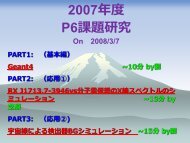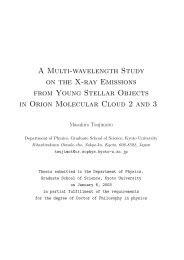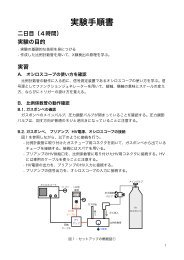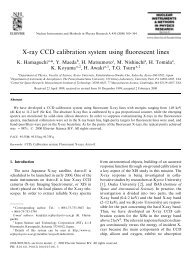X-ray Study of Low-mass Young Stellar Objects in the ρ Ophiuchi ...
X-ray Study of Low-mass Young Stellar Objects in the ρ Ophiuchi ...
X-ray Study of Low-mass Young Stellar Objects in the ρ Ophiuchi ...
Create successful ePaper yourself
Turn your PDF publications into a flip-book with our unique Google optimized e-Paper software.
98 CHAPTER 7. OVERALL FEATURE OF X-RAY EMISSION FROM YSOSsamples (Stelzer et al., 2000), for which <strong>the</strong>re was a significant difference between <strong>the</strong> distribution<strong>of</strong> flare < L X > <strong>of</strong> class II (CTTS) and class III+III c (WTTS) sources.Also, we see no significant difference <strong>of</strong> < L X > <strong>in</strong> <strong>the</strong> quiescent phase among all <strong>the</strong> classes.This is consistent with <strong>the</strong> previous estimation for this region with ROSAT derived by Grosso etal. (2000). They tried to estimate <strong>the</strong> significances ra<strong>the</strong>r strictly by consider<strong>in</strong>g <strong>the</strong> upper limit<strong>of</strong> undetected sources. Our samples give more severe constra<strong>in</strong>t because <strong>the</strong> detection thresholdis largely reduced to give <strong>the</strong> mean lum<strong>in</strong>osities <strong>of</strong> 10 29.5 –10 29.8 ergs s −1 , which is about 10 timeslower than that <strong>of</strong> ROSAT.7.3 Distribution <strong>of</strong> X-<strong>ray</strong> ParametersIn Figures 7.3–7.5, histograms <strong>of</strong> N H , < kT >, τ r , and τ d are shown for each class separately,toge<strong>the</strong>r with <strong>the</strong> mean values and standard deviations. We exclude <strong>the</strong> samples whose best-fitparameters and/or those errors are not determ<strong>in</strong>ed due to <strong>the</strong> limited statistics. For sources withmulti-temperature plasma (BF-46 and BF-96), we regard < kT > <strong>of</strong> <strong>the</strong> s<strong>of</strong>t and hard componentsas <strong>the</strong> quiescent and flare values, respectively, follow<strong>in</strong>g <strong>the</strong> discussion that <strong>the</strong> former wouldbe steady coronal emission while <strong>the</strong> latter is flare activity (§6.2). Like <strong>the</strong> case <strong>of</strong> L X , we estimate<strong>the</strong> significance level for <strong>the</strong> differences <strong>of</strong> <strong>the</strong>se parameters among all <strong>the</strong> classes with twononparametric two-sample tests <strong>in</strong> ASURV. The results are also given <strong>in</strong> Table 7.2.Absorption (N H )N H is distributed from 10 21.5 to 10 23.5 cm −2 (Figure 7.3). The mean value <strong>of</strong> N H ∼ 10 22.5 cm −2is roughly consistent with <strong>the</strong> average value through this cloud derived by <strong>the</strong> C 18 O radio observations(Tachihara et al., 2000). Also, <strong>the</strong> distribution <strong>of</strong> N H <strong>of</strong> class I sources is larger than that<strong>of</strong> <strong>the</strong> o<strong>the</strong>rs. Us<strong>in</strong>g ASURV, we estimate that <strong>the</strong> significance level <strong>of</strong> this tendency is ra<strong>the</strong>r high<strong>of</strong> 97 %. This supports <strong>the</strong> idea that X-<strong>ray</strong>s from class I sources come near <strong>the</strong> central sourcedeeply embedded <strong>in</strong> denser envelopes and suffer larger <strong>in</strong>tr<strong>in</strong>sic absorption.Plasma temperature (< kT >)Most <strong>of</strong> <strong>the</strong> < kT > values <strong>in</strong> <strong>the</strong> quiescent phase are <strong>in</strong> <strong>the</strong> range <strong>of</strong> 0.2–5 keV, while itbecomes systematically higher (1–10 keV) <strong>in</strong> <strong>the</strong> flare phase, <strong>in</strong>dicat<strong>in</strong>g <strong>the</strong> plasma heat<strong>in</strong>g dur<strong>in</strong>g<strong>the</strong> flare. Although <strong>the</strong> flare temperature <strong>of</strong> all classes is distributed around 3–4 keV, some flares <strong>of</strong>class I and II sources show higher temperature than 5 keV, while all flares <strong>of</strong> class III+III c sourceshave < kT > less than 5 keV. The mean values <strong>of</strong> < kT > dur<strong>in</strong>g flares for class I and II (4–5 keV)is <strong>the</strong>refore larger than that <strong>of</strong> class III+III c (2.7 keV).From Table 7.2, we see that both <strong>the</strong> GW and logrank tests for <strong>the</strong> difference <strong>of</strong> < kT >

















